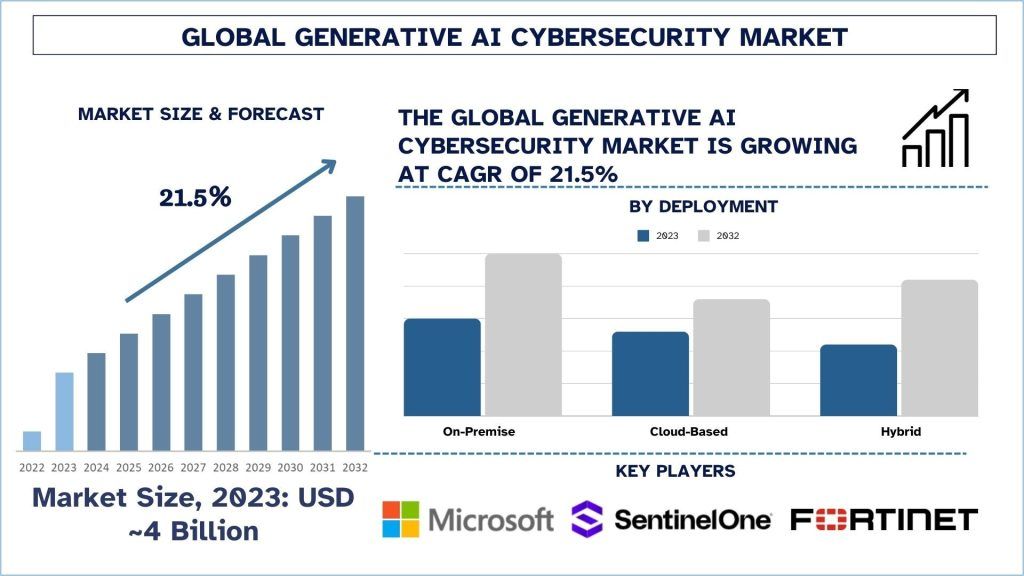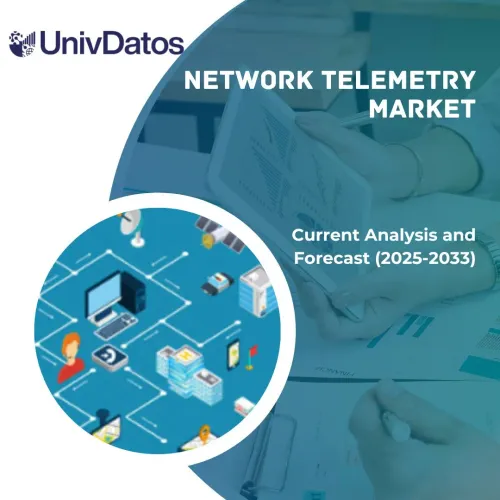- Home
- About Us
- Industry
- Services
- Reading
- Contact Us
Generative AI Cybersecurity Market: Current Analysis and Forecast (2024-2032)
Emphasis on Deployment (On-Premise, Cloud-Based, Hybrid); Technology (Generative Adversarial Networks (GANs), Variational Autoencoders (VAEs), Reinforcement Learning (RL), Deep Neural Networks (DNNs), Natural Language Processing (NLP), Others); Application (Network Security, Endpoint Security, Cloud Security, Application Security, Others); End-User (Banking, Financial Services, And Insurance (BFSI), Healthcare, Retail, IT & Telecom, Government and Defense, Energy and Utilities, and Others); and Region/Country
Generative AI Cybersecurity Market Size & Forecast
The Generative AI Cybersecurity market was valued at approximately USD 4 billion in 2023 and is expected to grow at a substantial CAGR of around 21.5% during the forecast period (2024-2032) owing to the rapid growth driven by the increasing complexity of cyberattacks.
Generative AI Cybersecurity Market Analysis
Generative AI Cybersecurity aims at the application of computer-based control systems for operating industrial facilities and processes through reduced human involvement. It improves the quality, speed, and safety of production as well as lessening the costs of production. With the help of the automated systems industries can manage processes, quality of their products, and even control the manufacturing process which will make it all faster and more accurate.
To attain growth in generative AI cybersecurity, companies are integrating AI for threat detection and mitigation, security intelligence and analytics, and security response orchestration. Also, the rising adoption of AI-based Security Operations Centers (SOCs), implementation of AI for network monitoring, and utilization of machine learning for emulation of attack scenarios. Some of the major organizations such as Microsoft, IBM, and Palo Alto Networks are already implementing it to improve their cybersecurity software and solutions.
On August 27, 2024, CrowdStrike (NASDAQ: CRWD) announced it is providing additional safeguards for NVIDIA NIM Agent Blueprints with the AI-native CrowdStrike Falcon cybersecurity platform to help developers securely leverage open-source foundational models and accelerate generative AI innovation.
On August 5, 2024, IBM (NYSE: IBM) announced the introduction of generative AI capabilities to its managed Threat Detection and Response Services utilized by IBM Consulting analysts to advance and streamline security operations for clients. Built on IBM’s watsonx data and AI platform, the new IBM Consulting Cybersecurity Assistant is designed to accelerate and improve the identification, investigation, and response to critical security threats.
Generative AI Cybersecurity Market Trends
This section discusses the key market trends influencing the various segments of the Generative AI Cybersecurity market as identified by our research experts.
Network Security Transform Generative AI Cybersecurity Industry
Network Security aims at shielding computer platforms from unauthorized entry and control disruption. There are specialized AI tools for network security that run continuously sense any form of anomaly, and react to it automatically, thus ensuring security for big and open networks. Moreover, companies integrate artificial intelligence-based network security to help protect enterprise networks from emerging threats. A robust market for generative AI in this segment is driven by the growing IoT environments and clouds that require protection. For instance, on May 2, 2024, Fortinet (NASDAQ: FTNT), the global cybersecurity leader driving the convergence of networking and security, announced new updates to its generative AI (GenAI) portfolio to enhance both network and security operations, including the industry’s first generative AI IoT security assistant.
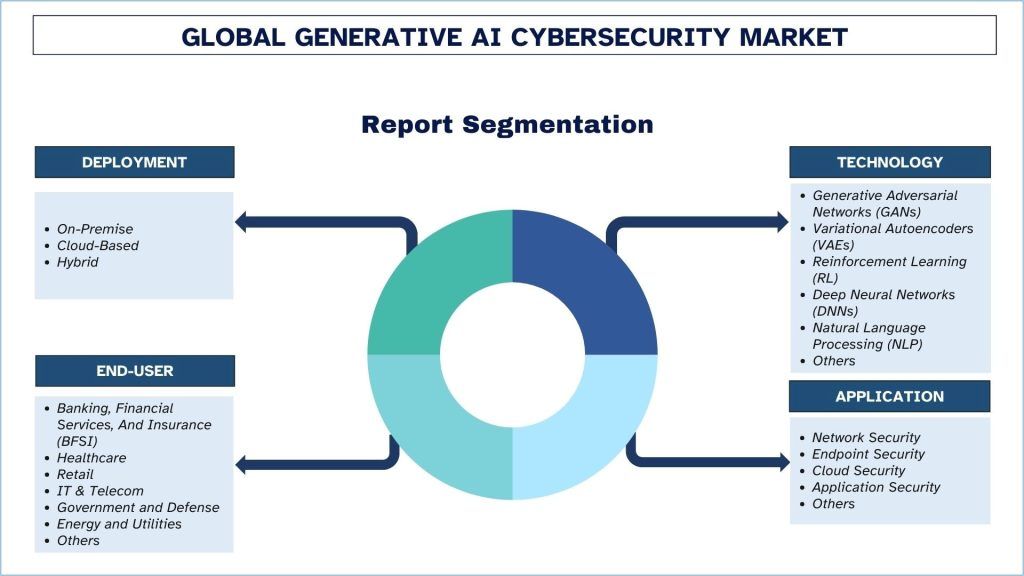
Asia-Pacific leads the growth.
The Asia-Pacific region is expected to lead growth in generative AI cybersecurity because of the quick shift to digitalization, accelerated cyber threat activity, and the widespread implementation of cloud services across sectors. Asia Pacific nations such as China, India, Japan, and Australia reported a rising number of cyber threats in recent years and companies are increasingly turning to AI-powered security platforms for better defense. Huawei, Tencent, and Infosys are amongst some of the companies starting to adopt generative AI within their cybersecurity systems to protect and ensure they remain in step with the latest legislation. The e-commerce, financial services, and manufacturing companies of the region are increasingly employing AI security due to the expansion of those sectors.
On August 29, 2024, Infosys, a global leader in next-generation digital services and consulting, announced the expansion of its collaboration with NVIDIA for AI-powered, customer-centric solutions to drive innovation and operational excellence for telcos. Leveraging Infosys Topaz, an AI-first set of services, solutions, and platforms using generative AI technologies, the collaboration will help telcos enhance their customer experiences, streamline network operations, and accelerate service delivery.
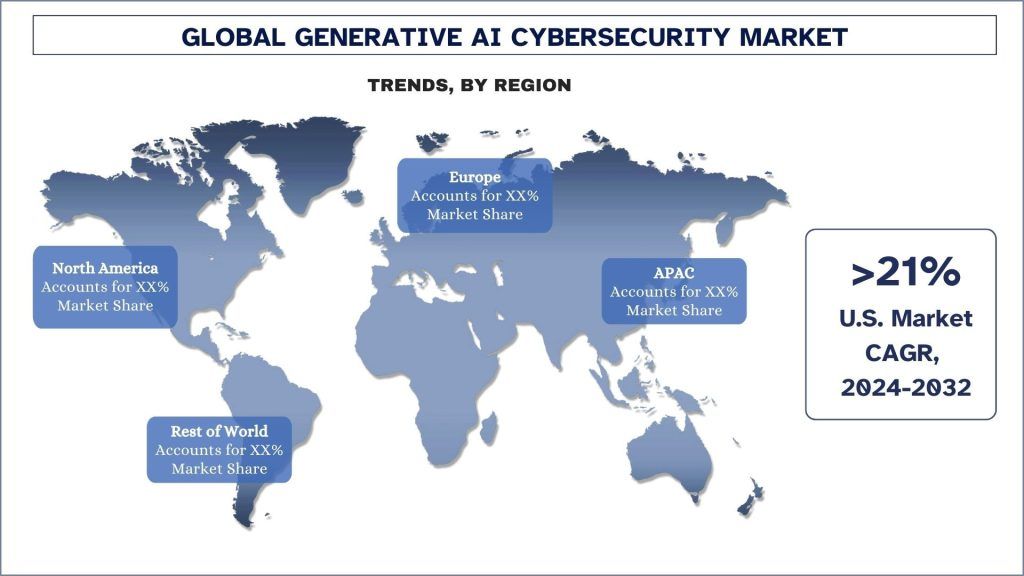
Generative AI Cybersecurity Industry Overview
The Generative AI Cybersecurity market is competitive, with several global and international players. The key players are adopting different growth strategies to enhance their market presence, such as partnerships, agreements, collaborations, new product launches, geographical expansions, and mergers and acquisitions. Some of the major players operating in the market are Microsoft; Amazon Web Services, Inc.; SentinelOne; Fortinet, Inc.; NVIDIA Corporation; CrowdStrike; Palo Alto Networks; IBM; Darktrace Holdings Limited; Cisco Systems, Inc.
Generative AI Cybersecurity Market News
- On March 28, 2023, Microsoft Corp. announced it is bringing the next generation of AI to cybersecurity with the launch of Microsoft Security Copilot, giving defenders a much-needed tool to quickly detect and respond to threats and better understand the threat landscape overall.
- On April 9, 2024, Microsoft announced an investment of USD 2.9 billion over the next two years to increase its hyperscale cloud computing and AI infrastructure in Japan. Also, expand its digital skilling programs to provide AI skills to more than 3 million people over the next three years, open its first Microsoft Research Asia lab in Japan, and deepen its cybersecurity collaboration with the Government of Japan.
- On March 18, 2024, CrowdStrike (NASDAQ: CRWD) announced a strategic collaboration with NVIDIA to deliver NVIDIA’s AI computing services on the industry-leading AI-native CrowdStrike Falcon® XDR platform. Combining Falcon platform data with NVIDIA’s GPU-optimized AI pipelines and software, including new NVIDIA NIM microservices, puts custom and secure generative AI model creation in the hands of CrowdStrike and NVIDIA customers.
Generative AI Cybersecurity Market Report Coverage
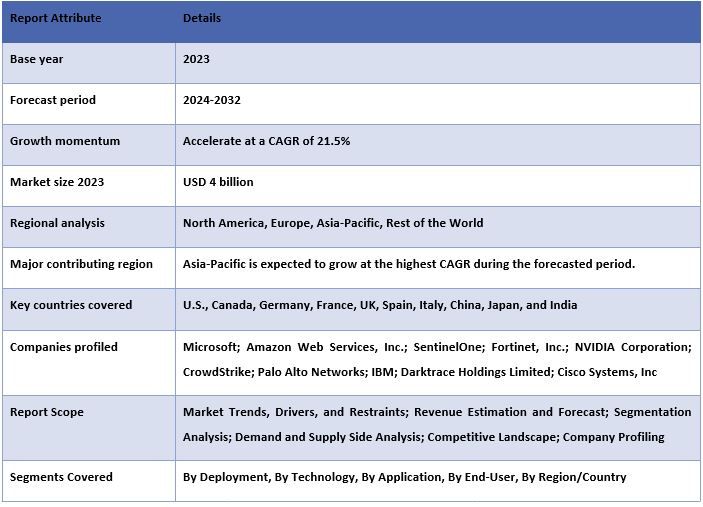
Reasons to buy this report:
- The study includes market sizing and forecasting analysis validated by authenticated key industry experts.
- The report presents a quick review of overall industry performance at one glance.
- The report covers an in-depth analysis of prominent industry peers with a primary focus on key business financials, product portfolios, expansion strategies, and recent developments.
- Detailed examination of drivers, restraints, key trends, and opportunities prevailing in the industry.
- The study comprehensively covers the market across different segments.
- Deep dive regional level analysis of the industry.
Customization Options:
The global Generative AI Cybersecurity market can be customized further as per the requirement or any other market segment. Besides this, UMI understands that you may have your own business needs, hence feel free to connect with us to get a report that completely suits your requirements.
Table of Content
Research Methodology for the Generative AI Cybersecurity Market Analysis (2022-2032)
Analyzing the historical market, estimating the current market, and forecasting the future market of the global Generative AI Cybersecurity market were the three major steps undertaken to create and analyze the adoption of Generative AI Cybersecurity in major regions globally. Exhaustive secondary research was conducted to collect the historical market numbers and estimate the current market size. Secondly, to validate these insights, numerous findings and assumptions were taken into consideration. Moreover, exhaustive primary interviews were also conducted, with industry experts across the value chain of the global Generative AI Cybersecurity market. Post assumption and validation of market numbers through primary interviews, we employed a top-down/bottom-up approach to forecasting the complete market size. Thereafter, market breakdown and data triangulation methods were adopted to estimate and analyze the market size of segments and sub-segments of the industry. Detailed methodology is explained below:
Analysis of Historical Market Size
Step 1: In-Depth Study of Secondary Sources:
A detailed secondary study was conducted to obtain the historical market size of the Generative AI Cybersecurity market through company internal sources such as annual reports & financial statements, performance presentations, press releases, etc., and external sources including journals, news & articles, government publications, competitor publications, sector reports, third-party database, and other credible publications.
Step 2: Market Segmentation:
After obtaining the historical market size of the Generative AI Cybersecurity market, we conducted a detailed secondary analysis to gather historical market insights and share for different segments & sub-segments for major regions. Major segments are included in the report as deployment, technology, application, end-user, and regions. Further country-level analyses were conducted to evaluate the overall adoption of testing models in that region.
Step 3: Factor Analysis:
After acquiring the historical market size of different segments and sub-segments, we conducted a detailed factor analysis to estimate the current market size of the Generative AI Cybersecurity market. Further, we conducted factor analysis using dependent and independent variables such as deployment, technology, application, end-user, and regions of the Generative AI Cybersecurity market. A thorough analysis was conducted for demand and supply-side scenarios considering top partnerships, mergers and acquisitions, business expansion, and product launches in the Generative AI Cybersecurity market sector across the globe.
Current Market Size Estimate & Forecast
Current Market Sizing: Based on actionable insights from the above 3 steps, we arrived at the current market size, key players in the global Generative AI Cybersecurity market, and market shares of the segments. All the required percentage shares split and market breakdowns were determined using the above-mentioned secondary approach and were verified through primary interviews.
Estimation & Forecasting: For market estimation and forecast, weights were assigned to different factors including drivers & trends, restraints, and opportunities available for the stakeholders. After analyzing these factors, relevant forecasting techniques i.e., the top-down/bottom-up approach were applied to arrive at the market forecast for 2032 for different segments and sub-segments across the major markets globally. The research methodology adopted to estimate the market size encompasses:
- The industry’s market size, in terms of revenue (USD) and the adoption rate of the Generative AI Cybersecurity market across the major markets domestically
- All percentage shares, splits, and breakdowns of market segments and sub-segments
- Key players in the global Generative AI Cybersecurity market in terms of products offered. Also, the growth strategies adopted by these players to compete in the fast-growing market
Market Size and Share Validation
Primary Research: In-depth interviews were conducted with the Key Opinion Leaders (KOLs) including Top Level Executives (CXO/VPs, Sales Head, Marketing Head, Operational Head, Regional Head, Country Head, etc.) across major regions. Primary research findings were then summarized, and statistical analysis was performed to prove the stated hypothesis. Inputs from primary research were consolidated with secondary findings, hence turning information into actionable insights.
Split of Primary Participants in Different Regions

Market Engineering
The data triangulation technique was employed to complete the overall market estimation and to arrive at precise statistical numbers for each segment and sub-segment of the global Generative AI Cybersecurity market. Data was split into several segments and sub-segments after studying various parameters and trends in the deployment, technology, application, end-user, and regions of the global Generative AI Cybersecurity market.
The main objective of the Global Generative AI Cybersecurity Market Study
The current & future market trends of the global Generative AI Cybersecurity market were pinpointed in the study. Investors can gain strategic insights to base their discretion for investments on the qualitative and quantitative analysis performed in the study. Current and future market trends determined the overall attractiveness of the market at a regional level, providing a platform for the industrial participant to exploit the untapped market to benefit from a first-mover advantage. Other quantitative goals of the studies include:
- Analyze the current and forecast market size of the Generative AI Cybersecurity market in terms of value (USD). Also, analyze the current and forecast market size of different segments and sub-segments.
- Segments in the study include areas of deployment, technology, application, end-user, and regions.
- Define and analyze the regulatory framework for the Generative AI Cybersecurity
- Analyze the value chain involved with the presence of various intermediaries, along with analyzing customer and competitor behaviors of the industry.
- Analyze the current and forecast market size of the Generative AI Cybersecurity market for the major region.
- Major countries of regions studied in the report include Asia Pacific, Europe, North America, and the Rest of the World
- Company profiles of the Generative AI Cybersecurity market and the growth strategies adopted by the market players to sustain the fast-growing market.
- Deep dive regional level analysis of the industry.
Frequently Asked Questions FAQs
Q1: What is the Generative AI Cybersecurity market's current size and growth potential?
Q2: What are the driving factors for the growth of the Generative AI Cybersecurity market?
Q3: Which segment has the largest share of the Generative AI Cybersecurity market by end-user?
Q4: What are the major trends in the Generative AI Cybersecurity market?
Q5: Which region will dominate the Generative AI Cybersecurity market?
Related Reports
Customers who bought this item also bought

